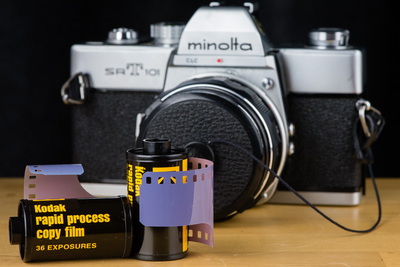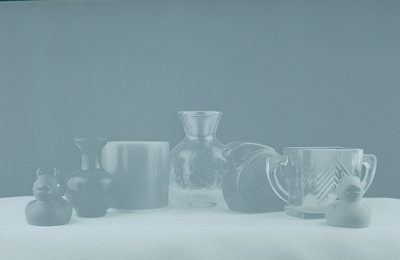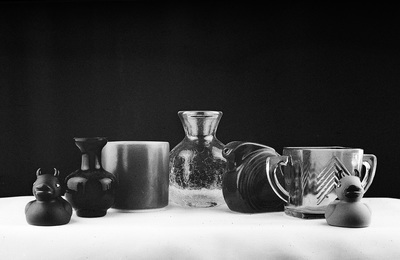Kodak Rapid Process Copy Film
A friend gave me a couple of rolls of Kodak Rapid Process Copy Film. This film, as near as I can tell, was last produced about 1993, so it’s 23 years old at least, maybe more. Based on what I’ve been able to find on the ’net, it was used to copy x-rays and other negatives.

Kodak RPC and Friend
I put some in my most manual 35mm camera, and learned that it’s unlike any film I’ve used so far.
First of all, it’s slow. S. L. O. W. Slow like in “11 stops slower than ISO100” slow. I was sort of prepared for this (thanks to the internet) but it still amazes me. To get a feel for it, I made some sample exposures at 10 second intervals and then developed them.
Here’s the one from 60 seconds:

RPC Rainbow (as scanned)

RPC Rainbow (edited)
Now what does 60 seconds mean in this context? When I metered this scene, I set my meter to ISO100 and f/8. That gave me a shutter speed of 1/30s. That’s a difference of about 11 stops [(1/30)*2^11 = 68]. In fact I probably could have made a longer exposure and it would have worked a bit better — my test went from 10 to 60 seconds and none of the images is overexposed.1 But at least I have a ballpark.
I developed it in Kodak HC-110 with a bit of a guess at a dilution. Some people say to use “Dilution E” which is (1+47), and some others use (1+49). I don’t have stock HC-110; I happen to have some premixed to “Dilution B” which is (1+31). After hemming and hawing with milliliters and ounces and trying to remember my high school chemistry calculations, I settled on 10 ounces of the premixed Dilution B plus 6 ounces of water. This is more than enough for one roll in my developing tank. I developed for 6 minutes: I agitated for 30 seconds to start, then for 10 seconds every minute thereafter. I used water to stop, then Ilford Rapid Fix (1+4), and then wash and dry.2
After developing, I was reminded of its second quirk: this is a positive film. That scan has not been inverted. (The blue cast is the color of the polyester base material.) It makes sense if you think about it — if the film was made to copy negatives, then you’d want it to be like the negative it copies. However, seeing the images as “positives” is disconcerting because my mind keeps trying to invert the black and white.3
Third, and possibly the most unusual for me, it’s orthochromatic. I regret not making a color version of the set, but the objects are (from left to right) Red, Orange, Yellow, Clear, Green, Blue, Purple. Orthochromatic emulsion is why blue-eyed people in really old pictures look strange. I would guess that most people wouldn’t notice the color shift if they didn’t know what the color of the subject was to begin with, so that’s something I can think about when I use the rest of the film.
What sort of images could be made that would take advantage of the properties of this film? Slow film means blurred moving objects, and depending on the location and the timing, it could make a normally busy city street sort of eerily quiet. Photographing subjects with well-known colors in the blue/red range might also lend some weirdness to an image. I think that’s where I’m going with this little project: make something seem not quite right, but I can’t put my finger on it.
I’ll finish up the roll that’s in the camera with some more experiments, next time with moving subjects outside in full sun and maybe at night. I think I will have to wait until it cools down a bit, though.
-
To be honest, I expected the “best” exposure to be in the 30 second range, but many factors could have affected the time, not the least of which is the age of the film or my development method. ↩
-
I didn’t use any Photoflo because I don’t have any. I might get some one day. ↩
-
At least it does until I get it scanned, then my “computer mind” takes over and it all seems normal again. ↩